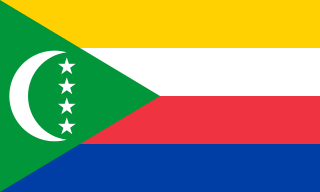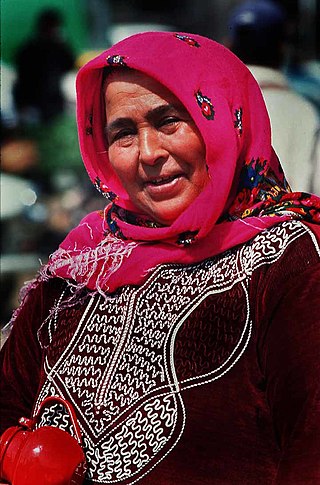
The Comoros, officially the Union of the Comoros, is an independent country made up of three islands in Southeastern Africa, located at the northern end of the Mozambique Channel in the Indian Ocean. Its capital and largest city is Moroni. The religion of the majority of the population, and the official state religion, is Sunni Islam. Comoros proclaimed its independence from France on 6 July 1975. A member of the Arab League, it is the only country in the Arab world which is entirely in the Southern Hemisphere. It is a member state of the African Union, the Organisation internationale de la Francophonie, the Organisation of Islamic Cooperation, and the Indian Ocean Commission. The country has three official languages: Shikomori, French and Arabic.

Mayotte, officially the Department of Mayotte, is an overseas department and region and single territorial collectivity of France. It is located in the northern part of the Mozambique Channel in the Indian Ocean off the coast of Southeastern Africa, between Northwestern Madagascar and Northeastern Mozambique. Mayotte consists of a main island, Grande-Terre, a smaller island, Petite-Terre, as well as several islets around these two. Mayotte is the most prosperous territory in the Mozambique Channel, making it a major destination for immigration.
This article is about the demographic features of the population of Mayotte, including population density, ethnicity, education level, health of the populace, economic status, religious affiliations and other aspects of the population. Mayotte's population density went from 179 persons per square kilometer in 1985 to 251 per square kilometer in 1991. Its capital, Dzaoudzi had a population of 5,865 according to the 1985 census; the island's largest town, Mamoudzou, had 12,026 people.

Polygyny is the most common and accepted form of polygamy around the world, entailing the marriage of a man with several women.
Polygamy is the practice of marrying multiple spouses. When a man is married to more than one wife at the same time, sociologists call this polygyny. When a woman is married to more than one husband at a time, it is called polyandry.

In modern usage, hijab generally refers to headcoverings worn by some Muslim women. It is similar to the wimple, apostolnik, and mantilla worn by some Christian women. While a hijab can come in many forms, it often specifically refers to a headscarf, wrapped around the head and neck, covering the hair, neck, and ears but leaving the face visible. The use of the hijab has been on the rise worldwide since the 1970s and is viewed by many Muslims as expressing modesty and faith. However, some Muslims maintain that the practice of covering the hair with a hijab is not mandated in Islam.

A burqa or a burka is an enveloping outer garment worn by some Muslim women which fully covers the body and the face. Also known as a chadaree or chaadar in Afghanistan and Pakistan, or a paranja in Central Asia, the Arab version of the burqa is called the boshiya and is usually black. The term burqa is sometimes conflated with the niqāb even though, in more precise usage, the niqab is a face veil that leaves the eyes uncovered, while a burqa covers the entire body from the top of the head to the ground, with a mesh screen which only allows the wearer to see in front of her. The burqa should also not be confused with the hijab, a garment which covers the hair, neck and all or part of the chest, but does not cover the face.
The persecution of Muslims has been recorded throughout the history of Islam, beginning with its founding by Muhammad in the 7th century.
Islamic clothing is clothing that is interpreted as being in accordance with the teachings of Islam. Muslims wear a wide variety of clothing, which is influenced not only by religious considerations, but also by practical, cultural, social, and political factors. In modern times, some Muslims have adopted clothing based on Western traditions, while others wear modern forms of traditional Muslim dress, which over the centuries has typically included long, flowing garments. Besides its practical advantages in the climate of the Middle East, loose-fitting clothing is also generally regarded as conforming to Islamic teachings, which stipulate that body areas which are sexual in nature must be hidden from public view. Traditional dress for Muslim men has typically covered at least the head and the area between the waist and the knees, while women's islamic dress is to conceal the hair and the body from the ankles to the neck. Some Muslim women also cover their face. However, other Muslims believe that the Quran does not mandate that women need to wear a hijab or a burqa.
Maore Comorian, or Shimaore, is one of the two indigenous languages spoken in the French-ruled Comorian islands of Mayotte; Shimaore being a dialect of the Comorian language, while ShiBushi is an unrelated Malayo-Polynesian language originally from Madagascar. Historically, Shimaore- and ShiBushi-speaking villages on Mayotte have been clearly identified, but Shimaore tends to be the de facto indigenous lingua franca in everyday life, because of the larger Shimaore-speaking population. Only Shimaore is represented on the local television news program by Mayotte La Première. The 2002 census references 80,140 speakers of Shimaore in Mayotte itself, to which one would have to add people living outside the island, mostly in metropolitan France. There are also 20,000 speakers of Comorian in Madagascar, of which 3,000 are Shimaore speakers.

Islam is very important to traditional Malian culture. Muslims currently make up approximately 95 percent of the population of Mali. The majority of Muslims in Mali are Malikite Sunni, influenced with Sufism. Ahmadiyya and Shia branches are also present.

A niqāb or niqaab, also called a ruband, is a garment, usually black, that covers the face, worn by some Muslim women as a part of an interpretation of hijab. Muslim women who wear the niqab do so in places where they may encounter non-mahram (un-related) men. Somewhat controversial in some parts of the world, the niqab is most often worn in its region of origin: the Arab countries of the Arabian Peninsula – Saudi Arabia, Yemen, and the United Arab Emirates, where it is common and considered as culturally belonging to the region, though not compulsory.

Islam is the official state religion in Tunisia. According to CIA, 99.1% of its adherents are Sunni Muslims. The constitution of Tunisia states that the country's “religion is Islam”, the government is the “guardian of religion”, and requires that the president be Muslim. The predominant madhhab in the country is the Maliki school. The Tunisian island of Djerba is home to a population of Ibadi Muslims.

Islam is the second largest religion in the United Kingdom, with results from the 2011 Census giving the total population as 2,786,635, or 4.4% of the total UK population, while the 2021 Census results released so far show a population of 3,868,133 (6.5%) in England and Wales, 3,801,179 in England and 66,950 in Wales. The 2011 census reported 76,737 Muslims in Scotland (1.45%). London has the greatest population of Muslims in the country. The vast majority of Muslims in the United Kingdom adhere to Sunni Islam, while smaller numbers are associated with Shia Islam.
Domoni is the second largest city on the Comorian island of Anjouan in the Indian Ocean and is located on the east coast of the island. It was the capital of the island in the past while the present capital of Anjouan is Mutsamudu.

A referendum on becoming an overseas department of France was held in Mayotte on 29 March 2009. Mayotte had been a departmental collectivity of France since 2001. In contrast to the four other similar regions, Mayotte would not have become an Overseas Department (DOM) or an Overseas Region (ROM), but would only have had a single assembly; the four other existing DOM/ROM will have the option of changing their status to this format as well.
Polygamy is illegal in France and has been the center of recent political debates, due to surges of Malian immigrants living polygamously in the country. Due to such, stricter laws have been enforced to stomp out polygamy.
The legal status of polygamy varies widely around the world. Polygyny is legal in 58 out of nearly 200 sovereign states, the vast majority of them being Muslim-majority countries. Polygyny is illegal in virtually every country but it’s not prohibited in Islam. In several non-Muslim countries in Sub-Saharan Africa and Asia, including India, Philippines, and Singapore, polygyny is only permitted among the Muslim population. Some countries that permit polygamy have restrictions, such as requiring the first wife to give her consent.

The Mahorese culture is characterized by the diversity of the cultural practices of its inhabitants.

The ongoing COVID-19 pandemic was confirmed to have reached the French overseas department and region of Mayotte on 10 March 2020. On 31 March, the first person died of COVID-19. In late April, the virus was out of control, and actively circulating on the island. On 16 August, Mayotte has been green listed.












